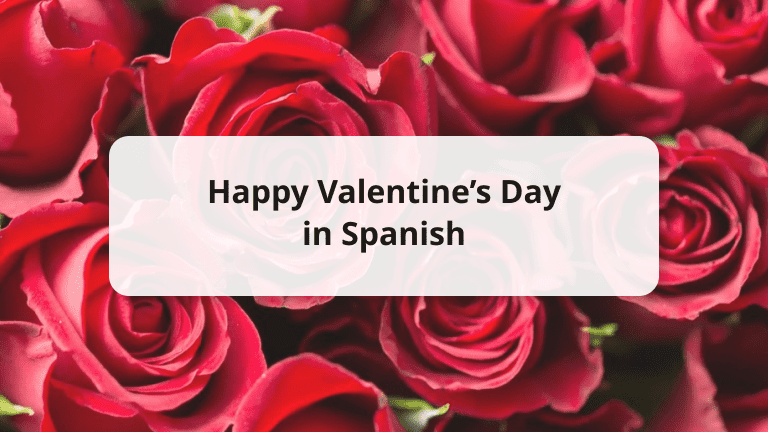How do you wish your significant other “Happy Valentine’s Day” in Spanish?-Ah yes, Valentine’s day, a day full of love that has Spanish boffins scratching their heads on how to win over someone’s heart in Spanish. The first step to achieve this is simple: to wish your Valentine to-be a “Happy Valentine’s Day” in Spanish, which is one of a few Romance languages.
There are three main ways to wish someone a “Happy Valentine’s Day” in Spanish, which we will be discussing in this article alongside other useful Spanish phrases and words to spread the love!
How to Say Happy Valentine’s Day in Spanish

Happy Valentine’s Day! – Feliz día de San Valentín
The most common way to say “Happy Valentine’s Day” in Spanish, so you will often hear this phrase being tossed around on this day. If you struggle to remember the other phrases, stick to this one.
You will often see the word feliz in these phrases, it means “Happy” in Spanish and feliz día means “Happy day” or “good day.”
Happy Love and Friendship Day – Feliz Día del Amor y la Amistad
Valentine’s day is also a day when the love between friends is celebrated, as such, Valentine’s day can also be seen as Friendship day! This phrase is nice to use when wishing friends a happy Valentine’s day.
Happy Lovers Day – Feliz Día de los Enamorados
A rather amorous version of the common phrase Feliz día de San Valentín (Happy Valentine’s Day). Your significant other might appreciate this phrase and set the tone for a love-filled celebration!

Other Quotes for Valentine’s Day in Spanish

Here is a list of other Spanish phrases that you can use on Valentine’s Day!
- I love you – Te amo
- I love you a lot – Te quiero mucho
- I need you – Te necesito
- I miss you – Te echo de menos
- I adore you – Te adoro
- You are the love of my life – Eres el Amor de Mi Vida
- You are always in my heart – Siempre estás en mi corazón
- I like you/Attracted to you – Me gustas
Valentine’s Day Words in Spanish

How about some Spanish verbs and nouns that will take your “Happy Valentine’s Day” in Spanish to a new level?
Additionally, you can learn how to say I miss you in Spanish or sweep your darlin’ one off their feet by learning different ways to call them beautiful in Spanish!
Related Spanish Nouns:
| Spanish Noun | English Translation |
|---|---|
| Cena | Dinner |
| Chocolate | Chocolate |
| Admirador | Admirer |
| Amor | Love |
| Corazón | Heart |
| Flor | Flower |
| Regalo | Present |
| Poema | Poem |
| Febrero | February |
| Catorce | Fourteen |
| Dulce | Sweet |
| Comprometido | Engaged |
| Cupido | Cupid |
| Sentimientos | Feelings |
| Romance | Romance |
Related Spanish Verbs:
| Spanish Verb | English Translation |
|---|---|
| Enamorarse | To fall in love |
| Abrazar | To hug |
| Querer | To love |
| Amar | To love |
| Besar | To kiss |
Difference Between Te Amo and Te Quiero

The Spanish phrases te amo and te quiero mean the same thing, “I love you”— but there are some differences that you should be made aware of, in a nutshell:
Te Quiero:
A subtle way to say “I love you”. This is used with boyfriends or girlfriends, but can also be used with long-time friends to express your love for each other.
Te amo:
A strong way of saying “I love you”. This phrase is used between married couples or long-term/serious relationships. You will also hear this phrase being used between parents and their children. Do not use this phrase with someone you have just met or in a new relationship.
There are a lot more differences between these phrases, and besides them, there are many more ways to say “I love you” in Spanish!
Valentine’s Day Around Spanish Speaking World

There are many Spanish-speaking countries each with its own unique way of celebrating Valentine’s day. Here are some country-specific valentine’s day traditions:
| Country | Date | Tradition |
|---|---|---|
| Guatemala | February 14 | El Día del Cariñ (Day of affection). Celebrate by throwing a parade for senior citizens, while dressing up in colorful costumes. |
| Bolivia | September 21 | El Día del Amor (Day of love). Love and friendship are celebrated with the start of spring. |
| Spain | February 14, April 23, and October 9 | Regions of Spain celebrate Valentine’s day on different dates; 14 February is El Día del Corte Inglés (Day of Corte Inglés), 23 April El Día de San Jorge (St. George’s Day), and 9 October El Día de San Dionisio (St. Dionysius Day). |
| Dominican Republic | February 14 | They play a game similar to the American secret Santa, which is called angelito (little angel) or amigo secreto (secret friend) |
| Colombia | 3rd Saturday of September | People send out gifts anonymously, or as secret admirers. |
| Argentina | February 14 and July 13-20 | Besides celebrating on the 14th of February, they also dedicate an entire week to Semana de la Dulzura (Sweetness week), which is exchanging candles and kisses. |
| Peru | February 14 | They exchange orchids to symbolize love. |
FAQs
Valentine’s day is called día de San Valentín in Spanish. The day is named after two Christian martyrs, ie, Saint Valentine. Originally, the day comprised a feast in their honor, and only later was it connected to love and romance.
Any of the phrases above can be used to romance your crush or significant other. Additionally, other romantic phrases include: Estoy loco/a por ti (I’m crazy about you) or Me has robado el corazón (You have stolen my heart).
Wish Your Lover a Happy Valentine’s Day in Spanish
Sweep your love interest off their feet this Valentine’s Day, Spanish-style! Go a step further and learn how to say I love you in French, which is the language of love, after all. Struggling with Spanish? Any other language? Look no further! At AmazingTalker., we have a variety of professional online language tutors, that can help you reach your language-learning goal from the comfort of your home!

















